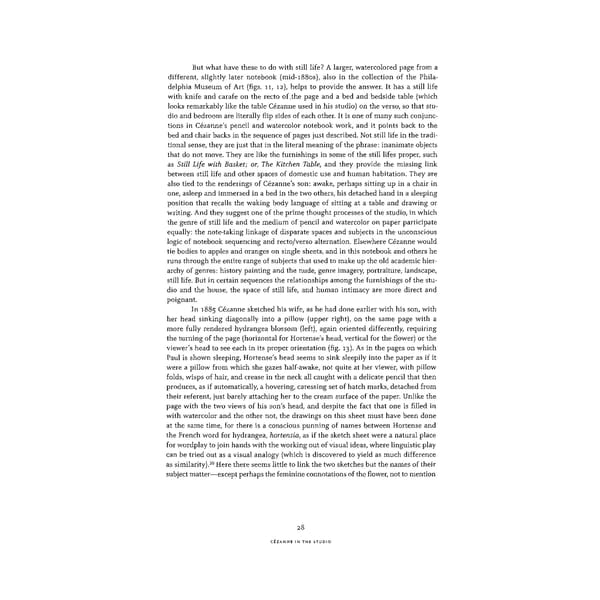But what have these to do with still life? A larger, watercolored page from a different, slightly later notebook (mid-i88os), also in the collection of the Phila- delphia Museum of Art (figs. 11, 12), helps to provide the answer. It has a still life with knife and carafe on the recto of .the page and a bed and bedside table (which looks remarkably like the table Cezanne used in his studio) on the verso, so that stu- dio and bedroom are literally flip sides of each other. It is one of many such conjunc- tions in Cezanne's pencil and watercolor notebook work, and it points back to the bed and chair backs in the sequence of pages just described. Not still life in the tradi- tional sense, they are just that in the literal meaning of the phrase: inanimate objects that do not move. They are like the furnishings in some of the still lifes proper, such as Still Life with Basket; or, The Kitchen Table, and they provide the missing link between still life and other spaces of domestic use and human habitation. They are also tied to the renderings of Cezanne's son: awake, perhaps sitting up in a chair in one, asleep and immersed in a bed in the two others, his detached hand in a sleeping position that recalls the waking body language of sitting at a table and drawing or writing. And they suggest one of the prime thought processes of the studio, in which the genre of still life and the medium of pencil and watercolor on paper participate equally: the note-taking linkage of disparate spaces and subjects in the unconscious logic of notebook sequencing and recto/verso alternation. Elsewhere Cezanne would tie bodies to apples and oranges on single sheets, and in this notebook and others he runs through the entire range of subjects that used to make up the old academic hier- archy of genres: history painting and the nude, genre imagery, portraiture, landscape, still life. But in certain sequences the relationships among the furnishings of the stu- dio and the house, the space of still life, and human intimacy are more direct and poignant. In 1885 Cezanne sketched his wife, as he had done earlier with his son, with her head sinking diagonally into a pillow (upper right), on the same page with a more fully rendered hydrangea blossom (left), again oriented differently, requiring the turning of the page (horizontal for Hortense's head, vertical for the flower) or the viewer's head to see each in its proper orientation (fig. 13). As in the pages on which Paul is shown sleeping, Hortense's head seems to sink sleepily into the paper as if it were a pillow from which she gazes half-awake, not quite at her viewer, with pillow folds, wisps of hair, and crease in the neck all caught with a delicate pencil that then produces, as if automatically, a hovering, caressing set of hatch marks, detached from their referent, just barely attaching her to the cream surface of the paper. Unlike the page with the two views of his son's head, and despite the fact that one is filled in with watercolor and the other not, the drawings on this sheet must have been done at the same time, for there is a conscious punning of names between Hortense and the French word for hydrangea, hortensia, as if the sketch sheet were a natural place for wordplay to join hands with the working out of visual ideas, where linguistic play can be tried out as a visual analogy (which is discovered to yield as much difference 20 as similarity). Here there seems little to link the two sketches but the names of their subject matter—except perhaps the feminine connotations of the flower, not to mention 28 CEZANNE IN THE STUDIO
 Cézanne in the Studio: Still Life in Watercolors Page 42 Page 44
Cézanne in the Studio: Still Life in Watercolors Page 42 Page 44